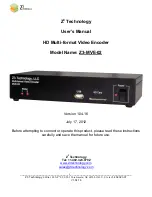
INSTALLATION INSTRUCTION 83
DP 6000 DIGITAL PAGING SYSTEM
Page 15/29
February 1997.
acknowledge, should be set in the opcode digit ‘3 U’ (default
value = 4). If a call is detected on one of the personal addresses
with this assigned bleep-pattern, and the transceiver is pro-
grammed for ‘old-system-mode’, the transceiver will bleep with
bleep-pattern No.3 until the reset button is pressed.
3.3.3 OPCODE 4 (INDICATION STATUS
(OPCODE 4 P)
Opcode digit 4 P sets the following functions :
BLEEP UNTIL RESET.
If this function is enabled the transceiver will bleep when called
until the reset button is pressed, or when the reset button is
not pressed the transceiver will bleep for a maximum duration
of 1 minute.
In PS versions, if an aknowledge is required by the central, for
example - to reset an alarm - the transceiver will emit a bleep
pattern continuously until the reset button is pressed.
LOW BATTERY BLEEP.
An automatic low-battery function is incorporated in the trans-
ceiver. Should the voltage drop below an acceptable level, a
voltage level indicator Fig. 1(A) will illuminate and a bleep-tone
emitted.
In systems with an alphadesk (PC fitted with LBB 6000 card))
the low battery state of the transceiver is sent to the alpha
desk. If acknowledged, the transceiver will remain in operation
for a maximum period of one hour. During this period, ‘low
battery’ will be indicated by a bar sign under the battery symbol
(Fig. 1, indicator (A)). If the batteries are not charged or
changed the transceiver will switch off automatically after this
period.
Before switching off a high volume bleep signal is given. If not
acknowledged by the alpha desk, i.e the transceiver is taken
outside the range of the system, the transceiver switches off
instantly, accompanied by a high volume bleep.
In a system without an alpha desk, the low battery state is indi-
cated by a short bleep which is emitted every two minutes for
a period of up to 1 hour. If no action is taken to charge or
change the batteries during this period, the transceiver will
switch off automatically followed by a high volume bleep signal.
OUT OF RANGE.
Each transceiver is equipped with an out-of range detection
facility. This warns the transceiver carrier that the transceiver
is outside the range covered by the DP6000 system. Out-of
range (see Note) is indicated by a bar sign under symbol Fig. ,
indicator (B) and a bleep signal which bleeps until reset. To
reset the bleep signal press the <Reset> key Fig.1(5). After 32
minutes continuously out-of-range, the transceiver switches off
automatically accompanied with a high volume bleep signal. To
remedy, re-enter the operational range of the DP6000 system
within 32 minutes, or switch the transceiver on again once in
range. When a PS 6000 transceiver is out-of-range an alarm will
always be present at the paging central control. This is due to
the transceiver not responding to check calls (automatically or
manually).
Note: The out-of-range function should be enabled both in the trans-
ceiver and the central equipment.
PERSONAL BLEEP ENABLE/DISABLE.
If the personal bleep is enabled personal bleep pattern 1 (as
programmed in the opcode 2) will sound when the transceiver
is called with codeinf 1 and personal bleep pattern 2 (as pro-
grammed in the opcode 3) will sound when the transceiver is
called with codeinf 2.
(OPCODE 4 Q) USER PROGRAM STATUS
Opcode 4 Q sets the user programming functions to the
required starting position.
(OPCODE 4 R) USER PROGRAM ENABLING
Opcode 4 R allows the installer to enable the choice of user
functions which can be used by the transceiver holder.
(OPCODE 4 S) ALARM STATUS
Opcode 4 S sets the on/off status of the alarms to the required
starting position.
(OPCODE 4 T) ALARM USER ENABLING
Opcode 4 T allows the installer to enable the user to modify
the on/off settings for the alarms via the user programming
menus.
OPTIONS (OPCODE 4 U)
In the last digit (U) of opcode 4 the different options can be
set :
-
Location transmission mode.
Location transmission from the transceiver to the central
control desk can be set to take place directly after the
transceiver has received a new location, or only after the
transceiver is scanned by the control desk. The reason for
this programmable option is to provide the installer with
the possibility to avoid to many uncontrolled location calls
in very busy systems. In systems using many transceivers
and/or location transmitters it is advisable to set the trans-
mission of locations to ‘only after the transceiver is
scanned’.
-
Manual alarm with audible bleep signal to enable rescuers
to locate the individual at risk, in darkness or smoke.
-
Location detection enable/disable.
-
No-move coupled to not vertical. If the no-move alarm
should only be transmitted if the angle detection is also
active, the bit in opcode digit 4U for no-move coupled to
not vertical should be set.
IMPORTANT: The angle alarm also should
be disabled and the no-move alarm should be
enabled (opcode digits 4S and 4T).















































